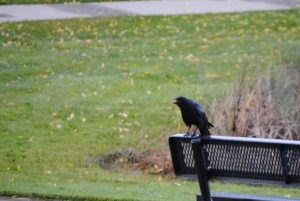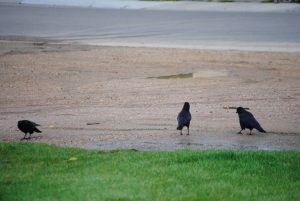This content was originally published by the Longmont Observer and is licensed under a Creative Commons license.
The second animal in my “spooky animals” series is the American crow, one of my favorites. These are highly intelligent and curious birds. While I was out taking pictures for this article, I got to see a family of crows grooming each other and one of the youngsters begging from an adult. I also got to see an interaction between a tenacious Cooper’s hawk and one of the crows. Because crows and ravens show up in some horror movies, I thought they deserved a place in my October series.
I’ll be focusing on the crow as that is what we tend to get in Longmont. Ravens usually occur at higher elevations. Crows and ravens are very similar in appearance, so here are a few tricks to tell them apart. Ravens are larger than crows, but unless you happen to have a crow and a raven side by side, this may not be much help. In flight, look at the tail feathers. Crows have a square-shaped tail whereas ravens have a V-shaped tail. Especially now, crows tend to travel in groups as compared to ravens that tend to travel in pairs. Ravens glide more and flap fewer times than crows do in flight as well. You can also tell them apart by their calls. Crows tend to give the quintessential cawing sound whereas ravens produce a lower croaking sound.

Crows are 15 to 20 inches in length and are completely black, including their bills. Adults have brown eyes whereas juveniles have blue eyes. Feathers have a glossy blue-violet, blue-green sheen to them. Their wingspan is 33 to 39 inches. Crows are roughly the size of a blue jay and about two thirds the size of a raven.
Highly adaptable birds, crows can be found any place where there are a few trees to perch in and a reliable food source. Crows will eat a wide variety of food including grains, seeds, nuts, fruits, berries, earthworms, and small mammals such as mice. They also eat insects, eggs, nestlings, carrion, and garbage. Crows primarily feed on the ground, but they have been known to follow birds to their nests where they can eat the eggs in the nest. Crows have also been known to steal food from other birds.
Crows do not breed until they are at least two years old, with many being four years old before breeding. During courtship, the male will face the female and fluff up his body feathers while partially spreading the wing and tail feathers. The male will bow repeatedly to the female and give a short, rattling song. Once a pair has formed, they will sit close to each other touching bills and preening each other. Both the male and the female will help build the nest, and sometimes young from the previous year will help as well. Nests are most often built in coniferous trees such as evergreens. When evergreens are not available, crows will nest in deciduous trees. Nests are placed in the crotch of a tree or on a horizontal branch near the top of the tree. They are primarily made up of twigs with an inner cup that is lined with soft materials such as pine needles, weeds, soft bark, or animal hair. Nests range in size from 6 to 19 inches in diameter.

Females lay three to nine eggs per clutch and can have up to two broods per season. Eggs are incubated for 16-18 days by the female. The female will give a begging call while incubating, and the male responds by feeding her. Occasionally, young from the previous year will also feed the female. Both parents and sometimes young from the previous year will help feed the young. Nestlings leave the nest four to five weeks after hatching.
Crows are territorial during the breeding season, but in the wintertime, they will gather in large flocks to roost at night. The same winter roost can be used for many years. Territories typically include the male and female pair and their offspring, which may also include offspring from the previous two years.
Crows are known to play, particularly juveniles and yearlings. They will pick objects up and carry them around, sometimes playing tug of war with other crows. Juveniles and adults both will play when there is a strong wind, flying into the wind and then flipping over. Items such as plastic cups and soda cans are used by juveniles to “log roll.”

As mentioned previously, crows are highly intelligent birds. Some captive crows have been observed making “tools.” In one example, a captive crow used a cup to carry water over to a bowl of dried food mash. Crows have also been observed using various items to stick down into holes to catch insects. They are able to recognize novel food items.
Crows and ravens are mentioned often in literature and mythology. Hindus believe that crows act as omens, giving people information about their life situation. Australian aboriginal myths see the crow as either a trickster, an ancestral being, or a cultural hero. Often the crow is associated with the theft of fire in aboriginal myths. In Irish mythology, the crow is associated with the goddess of war and death, Morrigan. Native American mythology sees the raven as either a trickster or the creator of the world. During Medieval times, crows were thought to predict rain and the future. In Greek mythology, the god Apollo turned the crow’s feathers from white to black in anger when the crow exposed his lover’s affair with a mortal. Whatever you believe about the crow, they are interesting to watch. Look for family groups in parks and fast food parking lots. You are sure to be entertained if you spend some time observing them.

